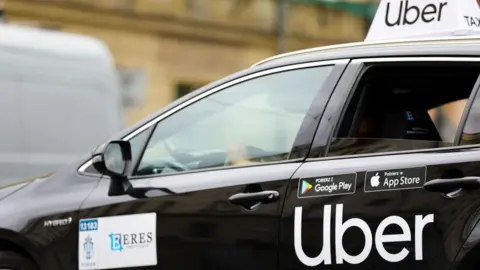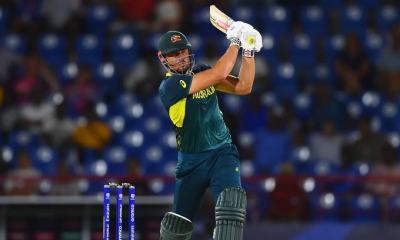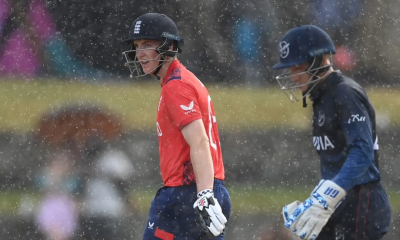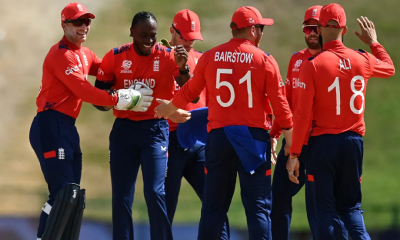Latest News
Broad signs off in style as England level series

Head joined Smith at the crease after Australia lost quick wickets and slipped to 169/3. Head struggled initially, beaten outside off multiple times, before getting into the thick of action with regular boundaries. Smith also found the fence from time to time, as they extended their partnership past 50 and brought the target below 150. In some late drama in the final over before Lunch, Moeen Ali got Smith to glove one to leg-slip where Ben Stokes timed his jump well to hold on to the ball but in his attempt to throw it, he hit his right knee and the ball popped out.
Woakes found movement straightaway in the final session and went past Smith’s outside edge on a couple of occasions while Moeen was getting sharp turn. Woakes also tested the outside edge of Head’s bat but the left-hander struck the first four of the session, playing one past mid-on. But Moeen and Woakes changed the tone of the match completely in just a few overs. Moeen lured Head into a drive, getting him to edge to slip while Smith fell after reaching fifty, squared up by Woakes to edge to slip. Moeen and Woakes then accounted for Mitchell Marsh and Mitchell Starc as Australia, who were going strong at 264/3, slipped to 275/7.
Alex Carey and Pat Cummins tried to resurrect the chase, with the two batters striking a boundary apiece. But Cummins fell in his attempt to pull a short ball from Moeen, handing the spinner his third wicket. Broad was brought back into the attack in what was his final spell and bowled in tandem with Moeen. But the England bowlers encountered resistance from Carey and Todd Murphy who put on a well-paced partnership to keep Australia interested and England frustrated. Carey also struck a six off Moeen coming down the track while Murphy pulled a Broad delivery for a four. But Broad ended England’s wait by getting Murphy to edge to the ‘keeper and nearly had Carey too if not for Crawley putting down the catch. The dream finish came soon enough as Broad had Carey caught behind to secure himself a winning farewell and a 2-2 finish to the Ashes.
Earlier, With overcast conditions welcoming the teams at The Oval on the final day, and a changed ball which had a lot more shine, there was assistance for the bowlers as Broad and Woakes tested the Australian openers. Woakes eventually made the breakthrough, getting David Warner (60) to edge behind. England lost a review when Broad went up for a leg-before shout against Marnus Labuschagne. But a short while later, Usman Khawaja burnt a review after being trapped in front by an incoming delivery from Woakes as he went back to the hut after a well-made 72. Labuschagne came out with a lot more intent compared to his first innings effort. But his promising stand with Smith was ended by Mark Wood who went wide of the crease to find the edge.
Australia, who retained the Ashes after the drawn fourth Test, asked England to bat first and had them in early trouble. But Harry Brook’s counter-attacking 85 and useful runs from Woakes and Wood helped the hosts post 283 in their first innings in less than 55 overs. Australia nearly batted double the number of overs to score 295, with Smith scoring 71 in their first essay. Joe Root (91), Jonny Bairstow (78) and Zak Crawley (73) led England’s charge in the second innings as they took only 81.5 overs to score 395. Australia replied with a century opening stand before Woakes and Moeen ran through their batting order, and Broad had his final dance to bring a fitting end to an evenly-contested Ashes.
Business
Trump heads to Saudi Arabia eyeing more investment in US

With US President Donald Trump due to visit Gulf states this week, a key focus will be securing significant new investment for the US economy.
“President Trump wants the announcement [of more Gulf money for the US],” says economist Karen Young, a senior fellow at the Middle East Institute think tank.
“He wants to have a big poster in a meeting that describes where these investments might go. And some estimation of what they will do to the American economy in terms of job creation or his big push, of course, on domestic manufacturing.”
Trump is due to arrive in the Saudi capital, Riyadh, on Tuesday 13 May, to meet the country’s de facto leader Crown Prince Mohammed bin Salman.
Trump is then expected to attend a summit of Gulf leaders in the city on 14 May, before travelling to Qatar that same day, and then ending his three-day trip in the United Arab Emirates (UAE) on 15 May.
The economic importance of the region to Trump is highlighted by the fact that the visit to Saudi Arabia was due to be the first overseas trip of his second term in the White House. That was before the death of Pope Francis necessitated Trump attending his funeral in Rome towards the end of April.
Saudi Arabia was also the first country that Trump visited during his first term of office, going against the modern practise of US presidents to start with the UK, Canada or Mexico.

Securing new investments in the US from Gulf states, and particularly from their state-backed sovereign wealth funds, will help Trump to signal back home that his “America First” agenda is delivering results.
The presidential visit is drawing top Wall Street and Silicon Valley leaders to Saudi Arabia. A Saudi-US investment forum on 13 May in Riyadh will feature CEOs from BlackRock, Palantir, Citigroup, IBM, Qualcomm, Alphabet, and Franklin Templeton.
The push comes amid economic headwinds, as President Trump’s new import tariffs have significantly disrupted global trade, confidence, and the US economy itself. US economic output fell in the first three months of this year, its first fall in three years.
Back in January, Prince Mohammed said that Saudi Arabia would invest $600bn (£450bn) in the US over the next years. However, Trump has already said that he’d like that to rise to $ 1tn, including purchases of more US military equipment.
According to Ali Shihabi – a Saudi commentator and author, with close ties to the Saudi government – a number of economic agreements will be signed during the trip.
“These deals will further integrate the Saudi and US economies together, joint ventures in the kingdom, in the United States, procurements of American weapons and goods,” says Mr Shihabi.
Saudi Arabia’s sovereign wealth fund, the Public Investment fund (PIF), which controls assets worth $925bn, already has numerous investments in the US. These include Uber, gaming firm Electronic Arts, and electric car firm Lucid.
Meanwhile, the UAE has already committed to investing $1.4tn in the US over the next 10 years, in sectors such as AI, semiconductors, energy and manufacturing. This was announced by the White House in March after the UAE’s national security advisor, Sheikh Tahnoon bin Zayed Al Nahyan, met President Trump in Washington.
Yet Ms Young from the Middle East Institute says that the scale of these investments is not realistic in the short term. She instead says that they are long-term strategic moves, and that the figures should be taken “with a little bit of a grain of salt”.
Regarding specific deals that could be announced during Trump’s visit, it is widely reported that Saudi Arabia will agree to buy more than $100bn of US arms and other military items.
These are said to include missiles, radar systems and transport aircraft.
The US has been a longstanding arms supplier to Saudi Arabia, but in 2021 the then Biden administration stopped selling Riyadh offensive weapons, citing concerns about the country’s role in the war in neighbouring Yemen.
The 2018 killing of Saudi journalist Jamal Khashoggi was also widely reported to be a factor. A US report said that Prince Mohammed had approved the murder.
The Biden White House resumed the sale of these weapons last year. While it cited that the Saudis had stopped bombing Yemen, some commentators said that the US was seeking Saudi assistance to help end the conflict in Gaza and aid its future reconstruction.

Mr Shihabi says Saudi Arabia will be seeking assurances from the White House that the US will implement a “more efficient procurement system”, enabling the Gulf state to access ammunition and military equipment far more quickly and easily.
“The Trump administration is initiating procedures to facilitate those deals. So, it’s expected that this process will improve immediately,” he adds.
Artificial intelligence is the other topic that will dominate the agenda during Mr Trump’s visit. Talks are expected to centre on attracting greater Gulf investment into US tech firms, and boosting the region’s access to cutting-edge American semiconductors.
The UAE and Saudi Arabia have been investing billions of dollars into tech and AI sectors as try to diversify their economies away from oil.
The Emiratis, in particular, are keen to establish themselves as a global AI hub.
Last week, the Trump administration scrapped the Biden-era chip regulations that placed restrictions on exports of advanced US chips to more than 120 countries including the Gulf states.
The White House is expected to draft new rules that would potentially involve direct negotiations with countries like the UAE.
“For the UAE, this is absolutely essential,” says Ms Young. “They are aggressively building out their AI capacity. So, for them getting access to US technology is imperative to be the best.”
While much attention will be on Trump courting Gulf capital for the US, Saudi Arabia is equally focused on drawing American investment into its ambitious Vision 2030 program.
Led by giant construction projects, such as the building of a linear city called The Line, Vision 2030 is central to the Saudi government’s continuing efforts to diversify the country’s economy away from oil.
It also involves pouring resources into entertainment, tourism, mining and sports.
However, foreign direct investment into Saudi Arabia declined for a third straight year in 2024, reflecting persistent challenges in attracting overseas capital.
The fall in global oil prices since the start of the year has further strained Riyadh’s finances, increasing pressure to either raise debt or cut spending to sustain its development goals.
Oil prices tumbled to a four-year low amid growing concerns that a trade war could dampen global economic growth.
The decline was further fuelled by the group of oil producing nations, Opec+, announcing plans to increase output.
Saudi Arabia is part of that group, and some commentators said that the rise was in part a desire to please Trump who has called for lower oil prices.
Other analysts said the reason was more that Opec+ remains confident that the global economy is growing.
The US-Saudi Business Council, is an organisation that aims to boost trade ties between the two countries.
It is hoping that Trump’s visit will push American businesses to explore more opportunities in Saudi Arabia, especially in sectors like AI, healthcare and education.
“The Saudi government is looking heavily to invest in these sectors. There is a very big appetite for Saudi companies to collaborate with American companies,” Hutham Al Jalal, who heads the Riyadh office for the organisation, tells the BBC.
Saudi officials are said to be confident that some deals in these sectors will be secured during Trump’s visit.
For Saudi Arabia, Trump’s visit is about strengthening ties with their longest-standing Western ally – a relationship that grew strained during the Biden years. For President Trump, it is about landing investment deals that can be framed as a win for his economic agenda.
“President Trump is looking for a headline of big investments in America, and he will get that from this trip,” adds Mr Shihabi.
[BBC]
Latest News
Pope Leo urges release of imprisoned journalists in first news conference

Pope Leo XIV demands the release of imprisoned journalists in the first news conference of his pontificate
Addressing the world’s media in Vatican City, he says he reiterates the Church’s solidarity with them for “seeking the truth” He also calls for “the precious gift of free speech” to be safeguarded, and adds: “Let us disarm words…so we can disarm the world”
[BBC]
Latest News
US and China agree to slash tariffs for 90 days

The US and China have agreed a deal that will significantly cut the import tariffs, or taxes, both sides have imposed on one another for a 90-day period.
US Treasury Secretary Scott Bessent said both countries would lower their reciprocal tariffs by 115% for 90 days.
The announcement came after the two countries held talks in Switzerland, the first between the two countries since US President Donald Trump had levied steep tariffs on Chinese imports.
The huge tariffs caused turmoil in the financial markets and sparked fears of a global recession.
President Trump had imposed a 145% tariff on Chinese imports, while Beijing responded with a 125% levy on some US goods.
However, the US tariffs on Chinese imports will now be cut to 30% for 90 days, while Chinese tariffs on US imports will be cut to 10% for the same period of time. The pause will begin on 14 May.
The US measures still include an extra component aimed at putting pressure on Beijing to do more to curb the illegal trade in fentanyl, a powerful opioid drug.
The imposition of the tariffs had raised the prospect of trade between the two countries slumping, with US ports reporting a sharp drop in the number of ships scheduled to arrive from China.
Meanwhile Beijing has become increasingly concerned about the impact the tariffs could have on its economy. Factory output has already slowed and there are reports some firms were having to lay off workers as production lines of goods bound for the US began to grind to a halt.
Announcing the agreement, Bessent said: “The consensus from both delegations this weekend is neither side wants a decoupling.
“What had occurred with these very high tariffs was the equivalent of an embargo, and neither side wants that.
“We do want trade, we want more balanced trade, and I think that both sides are committed to achieving that.”
China’s commerce ministry said the agreement reached with the US was an important step to “resolve differences” and “lay the foundation to bridge differences and deepen co-operation”.
News of the agreement boosted stock markets, with Hong Kong’s benchmark Hang Seng Index ending the day up 3%. China’s Shanghai Composite Index had closed before details of the deal came out, and ended 0.8% higher.
European stocks rose in early trade and early indications were that the main US stock markets will open up by 2-3%.
[BBC]
-

 Business7 days ago
Business7 days agoAitken Spence Travels continues its leadership as the only Travelife-Certified DMC in Sri Lanka
-

 Latest News5 days ago
Latest News5 days agoNPP win Maharagama Urban Council
-

 Business7 days ago
Business7 days agoLinearSix and InsureMO® expand partnership
-

 Features2 days ago
Features2 days agoSAITM Graduates Overcome Adversity, Excel Despite Challenges
-

 Business5 days ago
Business5 days agoJohn Keells Properties and MullenLowe unveil “Minutes Away”
-

 Sports2 days ago
Sports2 days agoASBC Asian U22 and Youth Boxing Championships from Monday
-

 News2 days ago
News2 days agoDestined to be pope:Brother says Leo XIV always wanted to be a priest
-

 Foreign News3 days ago
Foreign News3 days agoMexico sues Google over ‘Gulf of America’ name change
























